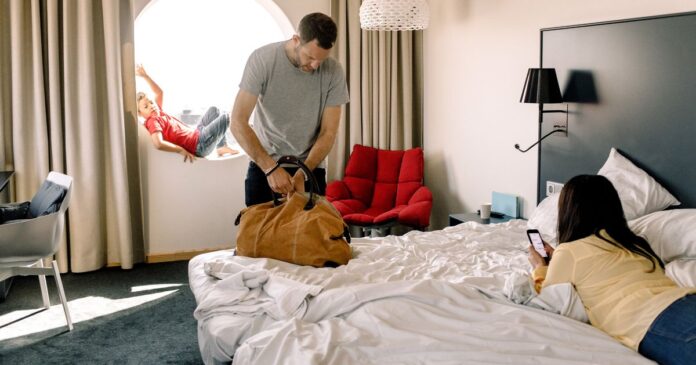Matthew Hairsnape, CEO of Triend, has shared his top nine tips for spotting something suspicious when it comes to reviews, including too many five stars and over-the-top language
Sometimes hotel reviews aren’t all that they seem (
Image: Getty Images/Maskot)
An expert has shared his top nine ways to spot fake reviews online to ensure you get the best deal from your holiday.
Matthew Hairsnape, CEO of Triend, has urged people to follow these tips so that they don’t end up disappointed during a trip away.
The problem of fake reviews is a very real and broad one.
In 2020 more than two million reviews were rejected or removed from Tripadvisor in 2020 for reasons including fraudulence, bias and violating community standards.
Matthew, whose new app Triend pays users to share unedited videos of locations while travelling in order to improve trust in reviews, gave the following bits of advice.
Make sure you don’t get duped by a dodgy review
(
Image:
Getty Images)
Extremely High Percentage Of 5-Stars
Check to see how many 5 star reviews there are.
Matthew said: “Although some people may very well have had a faultless experience at said place, it is very unlikely that no customer had an issue.”
Genuine positive reviews can include small points of improvement or note that something was not to their taste.
So, if an overwhelming amount of users found the place to be flawless, there is a good chance that you might be reading fraudulent reviews.
Over-The-Top Language
In a similar vein, be wary when a lot of reviewers appear to have raved about the place with flowery, extravagant language.
While there may be an odd one or two, the likelihood of several adopting such an over-enthusiastic approach is rather suspect.
“Overly decorative language suggests that these particular users are going out of their way to make the place sound ‘spellbinding’, for example,” Matthew said.
“This indicates that there is probably an ulterior motive and that would be getting people through the door.”
Extremely Negative Reviews
Too much negativity might be a warning sign
(
Image:
Getty Images)
On the other hand, you should exercise caution when there is a high amount of extremely negative reviews as well.
A lot of things can factor into your perception of a place, your mood on the day, what you order and your company.
“Some users project their own subjective criticisms onto reviews, colouring people’s opinions with negative preconceptions,” he continued.
“On a more sinister note, these slanderous reviews are sometimes posted by business competitors for their own gain.”
How early should I get to the airport? Tips for easyJet, BA, TUI and more flights
Brits share holiday disasters – including an ‘abandoned hotel’ and suspicious cocktails
Me, Me, Me
Research has shown that fraudulent reviews tend to contain an excessive amount of first-person pronouns like ‘me’ and ‘I’.
In an attempt to hide that their story is fake, some trolls over-emphasise the personal nature of their account to compensate for their lack of direct experience.
“If an account appears to be making a point of the first-handedness of their visit, instead of describing their surroundings, food or service, your alarm bells should be ringing,” Matthew warned.
It’s All In The Detail
Reviews which hone in on specific problems are more likely to be trustworthy
(
Image:
Getty Images/iStockphoto)
Be on the watch for vague reviews that glide over the experience without going into any specifics.
“Most genuine reviewers consciously go into the details of their experience in order to give an honest picture of their time there,” he said.
Whether that means mentioning that there was a crane blocking part of the view or they were served complimentary breadsticks at the start of a meal, these little remarks make a huge difference when assessing the credibility of a story.
Check The Dates
If a user claims to have tasted the worst Parisienne coq au vin one day then the most exquisite chilli crab in Singapore the next, something isn’t adding up.
Practice critical thinking when inspecting reviewers’ histories and be on the lookout for anything suspicious.
“Some people get hired to sit at a desk and falsify reviews in order to improve a business’ rating or sabotage its competition,” Matthew continued.
“It makes no difference to them if they review two places 10,000 km apart in one day. Therefore, assess the credibility of the dates and locations that users claim to have visited.”
Check Review Patterns
Some businesses may go out of their way to target rivals
(
Image:
Getty Images/iStockphoto)
If you aren’t sure whether to trust a review, have a look at the user’s writing patterns. Do they oscillate between glowing 5-star recommendations and 1-star pieces of scrutiny?
The app owner said: “Such extremes could suggest that the reviewer has an ulterior motive for posting such black and white opinions.”
No Face to the (Fake) Name?
The absence of profile pictures is also a bad sign. As fake reviewers don’t want to attach their identity to fraudulent information, they are unlikely to attach a photo of themselves or their real name to their account.
“Be careful when reading reviews from users that do not have a profile picture, have a highly extravagant name such as Theodore Goldenapple or one which is considered to be very common such as John Smith,” Matthew continued.
Customer Jacking
Be wary of reviews that slam one place but then go on to rave about one of its rivals. There is a high chance that the user is in some way linked to the competing business.
“A lot of the time, these types of comments come from someone trying to redirect customers towards a competing business,” he said.
Triend attempts to get round these problems by paying users for posting reviews and in turn, provides a clear and transparent financial incentive for them to share their honest thoughts and opinions.
Unedited video reviews that put a face to the reviewer’s name, holding them accountable for what they say and capturing their raw experience.
Geolocation technology that verifies that the review was filmed in the location that the user claims to be talking about.
Read More
Brits banned from wearing swim shorts and football shirts in Majorca resorts
Read More
Full list of UK rail strikes affecting Glastonbury Festival next week













